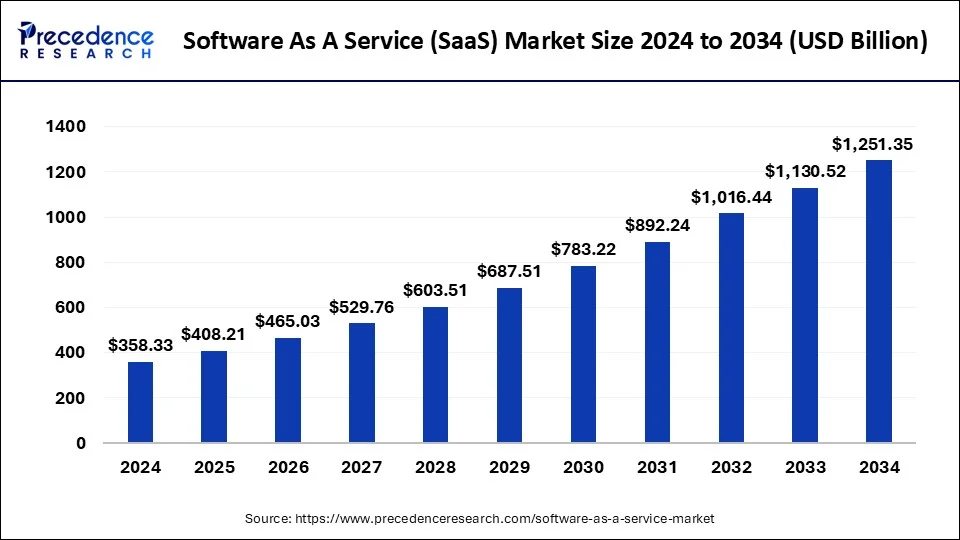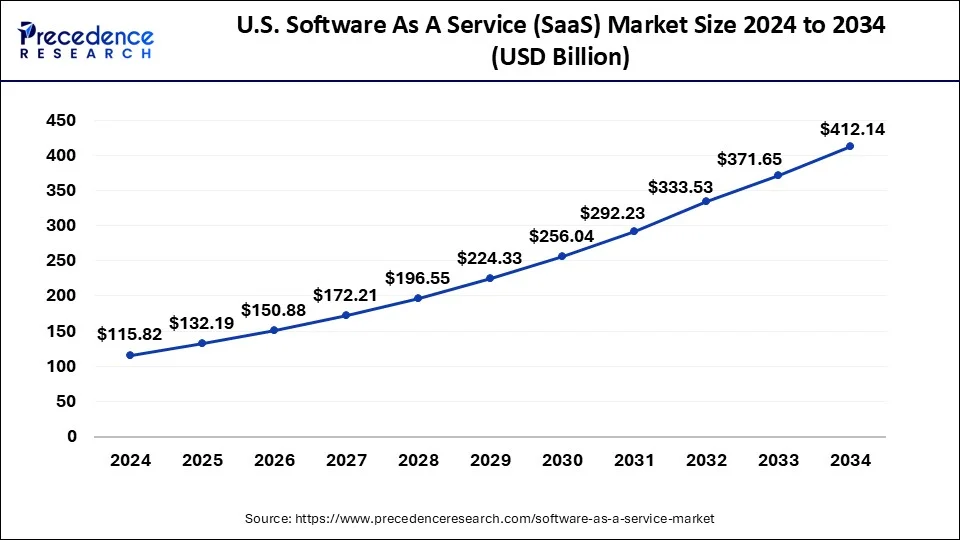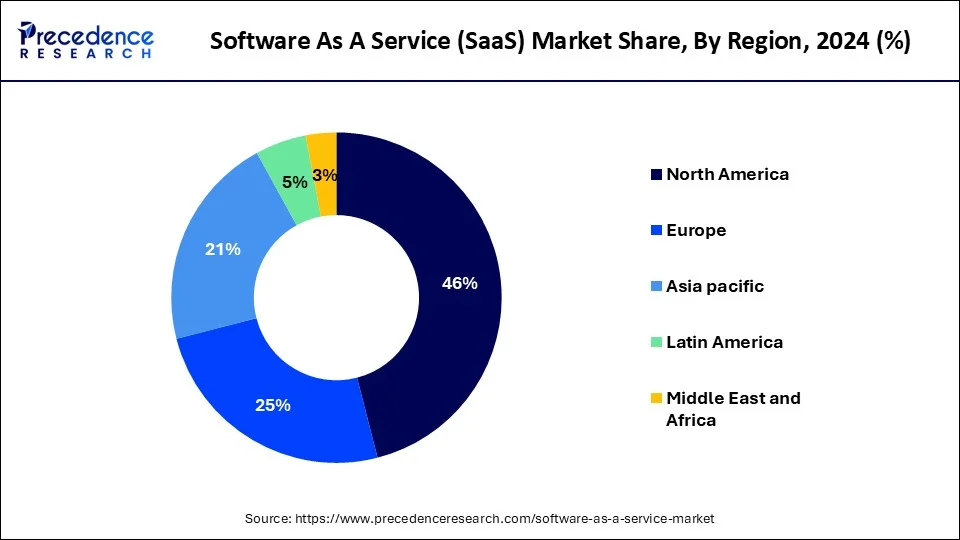November 2024
Software as a Service (SaaS) Market (By Deployment: Public Cloud, Private Cloud, Hybrid Cloud; By Enterprise-size: Small & Medium Enterprises, Large Enterprises; By Component: Software, Services; By Application: Customer Relationship Management, Human Capital Management, Enterprise Resource Planning, Content, Collaboration & Communication, Others; By End-User Industry) - Global Industry Analysis, Size, Share, Growth, Trends, Regional Outlook, and Forecast 2024-2034
The global software as a service (SaaS) market size was USD 314.54 billion in 2023, accounted for USD 358.33 billion in 2024, and is expected to reach around USD 1,251.35 billion by 2034, expanding at a CAGR of 13.3% from 2024 to 2034.

The U.S. software as a service (SaaS) market size was estimated at USD 101.47 billion in 2023 and is predicted to be worth around USD 412.14 billion by 2034, at a CAGR of 13.5% from 2024 to 2034.

The software as a service (SaaS) market is spread across North America, Europe, Asia Pacific (APAC), the Middle East and Africa, and Latin America. North America (NA) held the largest share of the global software as a service (SaaS) market in 2023. In 2023, the US accounted for the highest share followed by Canada and Mexico. Owing to the presence of countries with convenient economic policies, high gross domestic product (GDP), and quick adoption of the latest software as a service technology, the North American software as a service (SaaS) market is predicted to grow remarkably.
As of March 2023, the count of SaaS companies in the US and Canada was 17,000 and 2,000 respectively. SaaS companies from the US cater to nearly 14 billion customers across the world. The SaaS industry across the US is anticipated to account for a value of $225 billion by 2025.

The European software as a service (SaaS) market is segmented into Germany, France, the United Kingdom (UK), Italy, and the Rest of Europe. Germany is anticipated to hold the highest share of the European software as a service (SaaS) market during the study period. The count of SaaS unicorns raised from 44 in 2020 to 81 in 2021. In 2022, around 21% of the European tech community was of the opinion that hiring talent is one of the greatest challenges. This gave rise to the demand for various SaaS recruitment software. In 2020, the average European software as a service (SaaS) startup raised €1 million ($1.08 million) at seed. In 2021, this figure grew to €2.2 million ($2.49 million). The increasing funding is contributing enormously to the European software as a service (SaaS) market growth.
The software as a service (SaaS) market in the Asia Pacific (APAC) region is segmented into India, Japan, South Korea, China, and the rest of the Asia Pacific (APAC) region. In 2023, China held the highest share of the Asia Pacific (APAC) software as a service (SaaS) market followed by Japan and India. In 2020, the count of small and medium-sized enterprises (SMEs) in South Korea was approximately 7.3 million. This count is a remarkable rise from around 6.9 million small and medium-sized enterprises present in South Korea in 2019. The count of SMEs is increasing constantly in the Asia Pacific (APAC) region. Growing SMEs enhance the demand for respective software as a service (SaaS) promisingly.
Latin America, Middle East, and African (LAMEA) software as a service (SaaS) market is bifurcated into Saudi Arabia, United Arab Emirates (UAE), South Africa, North Africa, Brazil, Argentina, and the Rest of LAMEA. The Latin America region is predicted to account for notable growth in the software as a service (SaaS) market during the forecast period. In 2023, Brazil had the largest share in the LAMEA software as a service (SaaS) market region. Owing to unfavorable economic conditions, inadequate education, and lack of tech infrastructure in some African countries, the software as a service (SaaS) market in the African region is estimated to grow at a slower rate.
Market Overview
Software as a service (SaaS) refers to a method of licensing and software delivery wherein the software can be accessed online via a particular subscription. This method is different from buying and installing the software on every individual computer. The increasing adoption of public cloud services in various enterprises is one of the significant factors that is expected to drive the software as a service (SaaS) market growth during the study period. Considering the high cost of on-premises software deployment, many enterprises are shifting towards the SaaS model.
Software as a Service is delivered through a cloud delivery model. A software provider hosts a programmer and related data on its own servers, networks, computing resources, and databases. Software as a Service is highly correlated to on-demand computing software delivery models and application service providers.
As businesses aim to decrease their IT costs and enhance scalability, the adoption of Customer relationship management (CRM) SaaS solutions continues to increase. Configuration and customization of CRM SaaS solutions are becoming more accessible and easier. This allows companies to personalize their CRM systems as per to their particular requirements.
As the company grows, they require business-oriented SaaS platforms that are able to encode corporate policies, processes, and rules. SaaS platforms are also useful in improving communication, enhancing corporate efficiency, and exploring new revenue-generating market opportunities.
| Report Coverage | Details |
| Market Size in 2023 | USD 314.54 Billion |
| Market Size in 2024 | USD 358.33 Billion |
| Market Size by 2034 | USD 1,251.35 Billion |
| Growth Rate from 2024 to 2034 | CAGR of 13.3% |
| Largest Market | North America |
| Base Year | 2023 |
| Forecast Period | 2024 to 2034 |
| Segments Covered | By Deployment, By Enterprise-size, By Component, By Application, and By End-User Industry |
| Regions Covered | North America, Europe, Asia-Pacific, Latin America, and Middle East & Africa |
Growing cloud services all over the world are anticipated to boost the software as a service (SaaS) market drastically. The United States is a major destination for SaaS companies. Almost 56.67% of SaaS companies across the world are situated in the United States. The funding for software as a service (SaaS) platforms is increasing notably. Venture capital (VC) deals and investments in the United States in 2019 were valued at $35 billion. This amount increased to $38 billion in 2020. In 2021, the US SaaS VC investment accounted for $94 billion with 4,459 deals. Increasing investment is supporting the supply side of the SaaS market financially.
For enhancing the development of software as a service (SaaS), key market players can consider acquisition, collaboration, partnership, and joint ventures. Also, continuously evolving software technology can make the existing technology obsolete very soon. This is estimated to intensify the competition among the top market players.
Since the count of software as a service (SaaS) providers (suppliers) is less in comparison to the count of buyers, the bargaining power of suppliers is considerably high as compared to the bargaining power of buyers. Owing to remarkable profit margins, the threat of new entrants in the software as a service (SaaS) market is moderate as of now.
Our software as a service (SaaS) market report includes an in-depth analysis of the current market situation. The report includes essential aspects such as the competitive landscape, key players, the latest trends, and country-wise analysis. The analytical research on the impact of the pandemic of COVID-19 is helpful in knowing the effects on the demand and supply side. The segmental analysis provides a more distinct overview of different applications of software as a service (SaaS).
Based on deployment, the global software as a service (SaaS) market is segmented into public cloud, private cloud, and hybrid cloud. The private cloud segment held the largest market share in 2023. The private cloud segment is predicted to grow with the highest compounded annual growth rate (CAGR) during the study period.
Based on enterprise size, the global software as a service (SaaS) market is segmented into small & medium enterprises (SMEs) and large enterprises. The large enterprises segment had the highest revenue share in 2023. The large enterprises segment is estimated to grow with the highest compounded annual growth rate (CAGR) during the forecast period till 2034.
By application, the software as a service (SaaS) market is segmented into customer relationship management (CRM); enterprise resource planning (ERP); human capital management; content, collaboration & communication; BI & Analytics; and others. The customer relationship management (CRM) segment is anticipated to hold a substantial share during the forecast period.
Based on the end-user, the global software as a service (SaaS) market is segmented into banking, financial services & insurance (BFSI); retail & consumer goods; healthcare; education; manufacturing; travel & hospitality; and others. The financial services & insurance (BFSI) segment is estimated to hold a significant revenue share during the study period.
Segments Covered in the Report:
By Deployment
By Enterprise-size
By Component
By Application
By End-User Industry
By Geography
For questions or customization requests, please reach out to us at sales@precedenceresearch.com
No cookie-cutter, only authentic analysis – take the 1st step to become a Precedence Research client
November 2024
January 2025
January 2025
October 2024